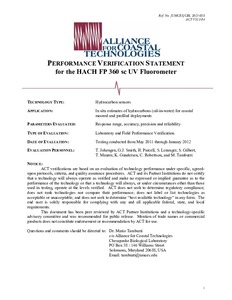| dc.contributor.author | Johengen, T. | |
| dc.contributor.author | Smith, G.J. | |
| dc.contributor.author | Purcell, H. | |
| dc.contributor.author | Loranger, S. | |
| dc.contributor.author | Gilbert, S. | |
| dc.contributor.author | Maurer, T. | |
| dc.contributor.author | Gundersen, K. | |
| dc.contributor.author | Robertson, C. | |
| dc.contributor.author | Tamburri, M. | |
| dc.date.accessioned | 2019-01-21T11:42:39Z | |
| dc.date.available | 2019-01-21T11:42:39Z | |
| dc.date.issued | 2013 | |
| dc.identifier.citation | Johengen, T.; Smith, G.J.; Purcell, H.; Loranger, S.; Gilbert, S.; Maurer, T.; Gundersen, K.; Robertson, C. and Tamburri, M. (2012) Performance Verification Statement for the HACH FP 360 sc UV Fluorometer. Solomons, MD, Alliance for Coastal Technologies, 44pp. (ACTVS12-04). DOI: http://dx.doi.org/10.25607/OBP-320 | en_US |
| dc.identifier.other | [UMCES]CBL 2013-018 | |
| dc.identifier.uri | http://hdl.handle.net/11329/763 | |
| dc.identifier.uri | http://dx.doi.org/10.25607/OBP-320 | |
| dc.description.abstract | Instrument performance verification is necessary so that effective existing technologies
can be recognized, and so that promising new technologies can become available to support
coastal science, resource management, and ocean observing systems. The Alliance for Coastal
Technologies (ACT) has therefore completed an evaluation of commercially available in situ
hydrocarbon sensors. This verification included test applications for: (1) controlled laboratory
tanks with additions of various organic, fluorescent compounds, (2) experimental wave tank with
additions of two sources of crude oils with and without dispersants, (3) a moored deployment in
Baltimore Harbor, and (4) hydrocast surveys in the Gulf of Mexico at a site near a submerged
leaking oil barge.
In this Verification Statement, we present the performance results of the Hach FP 360 sc
UV fluorometers. Quality assurance (QA) oversight of the verification was provided by an ACT
QA specialist, who conducted technical systems audits and a data quality audit of the test data.
Response specificity of the FP 360 sc to a range of organic compounds was evaluated in a
series of lab tests. The instrument output was based on a linear response photodetector behind
the emission optical filters and the data logger was configured to provide output with units of
ppb Oil concentration. Instrument response with respect to challenge compound concentration
varied with respect to the inherent fluorescence properties of the challenge compound as well as
sensor optics. As expected, the FP 360 sc exhibited concentration dependent linear responses to
several of the challenge compounds with response sensitivity ranked as carbazole >> quinine
sulfate > #2 Diesel Fuel > naphthalene disulfonic acid and was insensitive to basic blue. Trials in
the COOGER wave test tank at the Bedford Institute of Oceanography revealed linear responses
up to 1 ppm total added crude oil with a dynamic range similar to the laboratory based #2 Diesel
fuel challenge. Instrument response did vary with crude oil type and dispersion state. Instrument
responses to various challenge compounds converged when compared to standardized EEMs
fluorescence intensity estimated to correspond to the instruments emission optics.
Field deployments in Baltimore Harbor and northern Gulf of Mexico were equivocal as
all field reference samples were at or below the limit of detection for total petroleum
hydrocarbons (≤ 25 ppb), yet for Baltimore Harbor the FP 360 sc output was above the baseline
response in deionized water and somewhat consistent with environmental background
fluorescence as determined by EEMs analysis. There was no clear instrument response to EEMs
intensities in the Gulf of Mexico profiling test, however it is unclear if the response may have
been impacted by the use of a second party data logger for this profiling application.
During this evaluation, no problems were encountered with the provided software, set-up
functions, or data extraction at any of the test sites. One hundred percent of the data was
recovered from the instrument and no outlier values were observed for any of the laboratory
tests, field deployment tests, or tank exposure tests. In general, results indicate that for all types
of test application including lab, moored and hydrocast surveys, the ambient fluorescence
properties of the challenge solution need to be accounted for to make quantitative hydrocarbon
estimates from these sensors.
We encourage readers to review the entire document for a comprehensive understanding
of instrument performance. | en_US |
| dc.language.iso | en | en_US |
| dc.publisher | Alliance for Coastal Technologies (ACT) | en_US |
| dc.relation.ispartofseries | ACT VS; 12-04 | |
| dc.rights | CC0 1.0 Universal | * |
| dc.rights.uri | http://creativecommons.org/publicdomain/zero/1.0/ | * |
| dc.title | Performance Verification Statement for the HACH FP 360 sc UV Fluorometer. | en_US |
| dc.type | Report | en_US |
| dc.description.status | Published | en_US |
| dc.format.pages | 44pp. | en_US |
| dc.description.refereed | Refereed | en_US |
| dc.publisher.place | Solomons, MD | en_US |
| dc.subject.parameterDiscipline | Biogeochemistry | en_US |
| dc.description.currentstatus | Current | en_US |
| dc.description.eov | Ocean Colour | en_US |
| dc.description.bptype | Best Practice | en_US |
| dc.description.bptype | Standard Operating Procedure | en_US |
| obps.contact.contactemail | info@act-us.info | |
| obps.contact.contactemail | tamburri@umces.edu | |
| obps.resourceurl.publisher | http://www.act-us.info/evaluations.php | en_US |
 Repository of community practices in Ocean Research, Applications and Data/Information Management
Repository of community practices in Ocean Research, Applications and Data/Information Management

